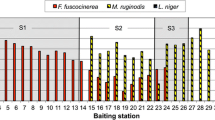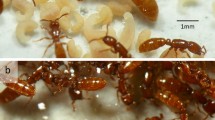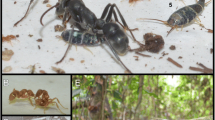Summary
A search forAneuretus simoni was carried out in forested regions near Kandy, Matale, Peradeniya, Gilimale, Ratnapura, and Lagumba, Sri Lanka. Colonies were found only in the humid forests of the Gilimale area. The distribution ofA. simoni appears to be correlated with rainfall (200–500 cm/year) and geographic elevation (above 450 meters). A total of 33 queenright and queenless nests were collected. Nest density was 0.017, 0.023, and 0.033 colonies/m2, respectively, in three study plots.
Aneuretus colonies contain on average more than one queen and approximately 65 minor workers. Major workers comprise only two to three percent of the colony population. Sexuals are found in nests from mid-July to August. Colonies appear to be polydomous.
A. simoni workers observed in the field showed generalized foraging habits. They preyed upon small insects and collected carbohydrate from rotting fruit. Trail systems were used in exploitation of large food sources.
A. simoni workers typically avoid contact with workers of sympatric ant genera such asPheidole, Paratrechina, Tetramorium, Odontomachus, andMonomorium. When alien conspecifics are encountered, aggression results, indicating that nestmate recognition and perhaps intraspecific territoriality is well developed.
Resume
La fourmi primitiveAneuretus simoni a été recherchée au Sri Lanka dans les forêts de Kandy, Matale, Peradeniya, Gilimale et Ratnapura. Des sociétés de l'espèce ont pu être trouvées dans les seules forêts humides de Gilimale. La répartition de cette fourmi semble localisée aux zones d'altitudes supérieures à 450 m recevant de 2 à 5 mètres d'eau par an. Au total, 33 sociétés ont pu être récoltées, dont plusieurs avec des reines. Les densités des sociétés étaient respectivement de 0.017, 0.023 et 0.033 soc/m2 dans les 3 sites étudiés.
Nous avons dénombré chezA. simoni une moyenne de 65 ouvrières minor et une ou plusieurs reines par société. Les ouvrières major ne représentent que 2 à 3 % des effectifs. Les sexués apparaissent du milieu du mois de juillet au mois d'août. La société semble polycalique.
Dans leur habitat habituel, les ouvrières sont omnivores. Elles consomment des petits insectes et des hydrates de carbone prélevés sur des fruits pourrissants. Un système de pistes de récoltes est utilisé dans l'exploitation de sources de nourriture importantes.
Les ouvrières d'A. simoni évitent typiquement tout contact avec celles de fourmis sympatriques commePheidole, Paratrechina, Tetramorium, Odontomachus etMonomorium. En cas de rencontre avec des ouvrières étrangères de la même espèce, il en résulte des phénomènes d'agression. Ceci suggère que la reconnaissance des congénères d'une même société et peut être l'existence d'un comportement territorial intraspécifique semblent bien développés.
Similar content being viewed by others
References
Bingham C.T. 1903. — The fauna of British India including Burma and Ceylon.Hymenoptera, Vol. II. Ants and Cuckoo-wasps. Taylor and Francis, Fleet Street, London, 282 p.
Brown Jr., W.L., 1973. — The comparison of Hylean and Congo-West African rainforest ant faunas. pp. 161–185. In:Tropical Forest Ecosystems in Africa and South America: a Comparative Review. (Meggers B.J., Ayensu E.S., and Duckworth, D., eds.). Smithsonian Institute Press, Washington, D.C.
Emery C., 1893. — Voyage de M.E. Simon dans l'île de Ceylan: Formicides.Ann. Soc. Ent. de France,62, 239–252.
Forel A., 1913. — Wissenschaftliche Ergebnisse einer Forschungsreise nach Ostindien. II. Ameisen aus Sumatra, Java, Malacca, und Ceylon.Zool. Jahrb. Syst. 36, 87–145.
Jayasuriya A.K., 1980. —The behavior and ecology ofAneuretus simoni Emery. Unpublished A.B. thesis, Harvard University, Cambridge, Massachusetts, USA.
Taylor R.W., 1978. —Nothomyrmecia macrops: a living-fossil ant rediscovered.Science, 201, 979–985.
Traniello J.F.A., Jayasuriya A.K., 1981a. — The sternal gland and recruitment communication in the primitive antAneuretus simoni.Experientia, 37, 46.
Traniello J.F.A., Jayasuriya A.K., 1981b. — Chemical communication in the primitive antAneuretus simoni: The role of the sternal and pygidial glands.J. Chem. Ecol., 7, 1023–1033.
Traniello J.F.A., Jayasuriya A.K., 1985b. — The biology of the primitive antAneuretus simoni Emery. II. The social ethogram.Insect Soc., 32, 375–388.
Wilson E.O., 1971. —The insect societies. Harvard University Press, Cambridge, Massachusetts, USA, 548 p.
Wilson E.O., Eisner T., Wheeler J., 1956. —Aneuretus simoni Emery, a major link in ant evolution.Bull. Mus. Comp. Zool., Harvard,115, 81–99.
Author information
Authors and Affiliations
Rights and permissions
About this article
Cite this article
Jayasuriya, A.K., Traniello, J.F.A. The biology of the primitive antAneuretus simoni (Emery) (Formicidae: Aneuretinae) I distribution, abundance, colony structure, and foraging ecology. Ins. Soc 32, 363–374 (1985). https://doi.org/10.1007/BF02224014
Received:
Accepted:
Issue Date:
DOI: https://doi.org/10.1007/BF02224014




